I’ll be honest, in the past I’ve been more of a melted cheese, chocolate, and fresh bread kind of person…all the things my naturopathic doctor says for me to avoid. I mean, I’m a ketchup person – never mustard! So this dill pickles recipe, olives, and other sour or fermented foods have not been on the top of my list for favorite foods until the past few years.
I live in a house of people who love fermented foods. I’m so glad, because of the health benefits. After trying fermented foods, slowly and surely I’ve come to find recipes that I absolutely love. This is one that even a non-fermented foods person can enjoy.
Fermented foods are SO incredibly good for you! Well, everything depends on how it’s made and with what. But traditionally, foods fermented with wild bacteria or yeast are excellent for your gut.
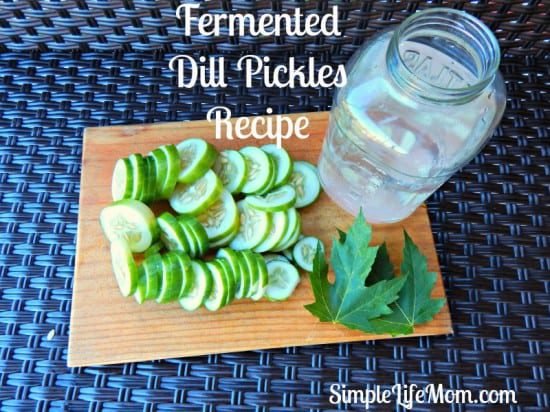
Your intestines are the powerhouse of good bacteria in your body. This is the bacteria that helps you digest properly, helps your immune system stay strong. There should be about 3 pounds of good bacteria growing in your gut. Wipe that out, like we do when we take antibiotics (which I’m not saying are not necessary sometimes), and our bodies are in deep trouble, which is why we take probiotics during and after any antibiotic treatment.
What is Lacto Fermentation?
Lacto stands for lactobacillus, the name of a type of bacteria that grows on plants and in our intestines.There are different types of lactobacillus bacteria, one is the lactobacillus acidophilus that you may see on a yogurt label.
Through the fermentation process, this wonderful bacteria converts sugars into lactic acid (whether those sugars be in cucumbers, cabbage, or sourdough bread. This lactic acid makes sure no bad bacteria can grow. So your fermented foods are safe! Though we must make sure that there is enough lactic acid. Sometimes some bad bacteria can be introduces, which I will talk about below.
According to Cultures for Health, lacto fermentation also produces antibiotic and anti-carcinogenic qualities in our foods by raising the levels of certain vitamins and enzymes.
***Note*** Your pickles or sauerkraut from the store are not fermented, but are pickled in vinegar. This loses a lot of the good qualities that you would have by fermenting your foods.
So, what are we waiting for? You can definitely start making your own dill pickles.
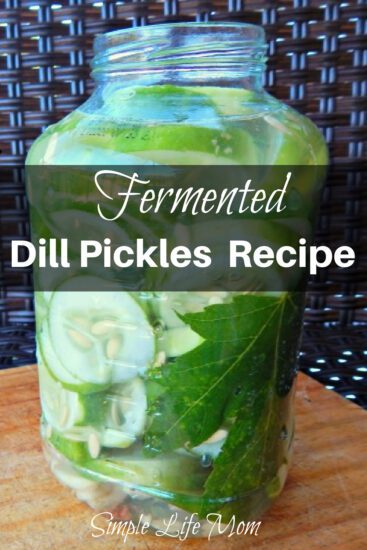
Fermented Dill Pickles Recipe
This recipe is for one 32 ounce jar of pickles. Fit as many cucumbers into the jar as you can while making sure they do not go above the rim. The cucumbers need to be fully submerged.
Double or triple the recipe, depending on how many cucumbers you have to pickle.
Remember that it’s very important to keep all cucumbers submerged at all times.
Ingredients:
- 2-1/2 tablespoons sea salt
- 32 ounces filtered water (it needs to be filtered. Chlorine will kill the fermentation process)
- 3 garlic cloves, sliced
- 1 spring fresh dill, or 1 tablespoon dried dill
- 1 teaspoon whole peppercorns
- 2 grape leaves (oak or horseradish leaves are a substitute)
- 3-5 pickling cucumbers (enough to fill the jar)
Instructions:
- Add salt, filtered water, garlic cloved, dill, and peppercorns to a 32 ounce mason jar. You can use another bowl but mason jars allow you to submerge the cucumbers more easily.
- Stir with a wooden spoon until the salt is dissolved.
- With clean hands, add the cleaned cucumbers and leaves. Water will overflow, but that’s fine. Do it in the skink so that when you are done the water is to the brim.
- Make sure no cucumbers are touching the surface of the water. If you do not have fermenting equipment, put some water in a zip close bag and place on top of the jar to keep the cucumbers down. You do want air to be able to touch the surface of the water, but you do not want cucumbers poking out either.
- Let sit on the counter top for 3-5 days. The jar will begin to bubble. You’ll know they are done when the bubbles stop.
- Seal and refrigerate until eaten.
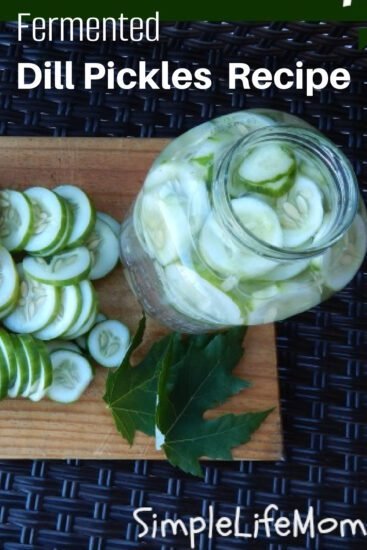
Fermented Dill Pickles Recipe
Equipment
Ingredients
- 2-1/2 Tbsp sea salt
- 1 quart filtered water
- 3 cloves garlic sliced
- 1 sprig fresh dill or 1 Tbsp dill seeds
- 1 tsp peppercorns
- 2 leaves grape or oak or horseradish if you have them
- 3-5 Pickling cucumbers enough to fill the jar
Instructions
- Add the salt, filtered water (it cannot have chlorine in it), cloves, dill, and pepper in jar.2-1/2 Tbsp sea salt, 1 quart filtered water, 3 cloves garlic, 1 sprig fresh dill, 1 tsp peppercorns
- Stir with a wooden spoon until the salt is dissolved.
- With clean hands, add the leaves and cleaned cucumbers. Water will overflow, but that's fine. Do it in the sink so that when you are done the water is to the brim.2 leaves grape, 3-5 Pickling cucumbers
- Make sure no cucumbers are touching the surface of the water (place a leaf on top to help). If you do not have fermenting equipment, you can place plastic wrap over the jar, touching the water to help prevent air from touching any cucumber as they shift. Or, if your jar mouth is wider, place a zip-top bag with water in it on top of the jar to weight the pickles down (you may need to tape the bag onto the jar).
- Let sit for 3-5 days on your counter top. It will ferment faster if you have a warm home or a warm location during the summer. The jar will start to produce bubbles. You'll know it's ready when the bubbles stop.
- Seal and refridgerate until eaten.
Notes
Problem Shooting:
- Make sure your hands and jar are sterilized, otherwise you will introduce bad bacteria.
- If you get some cloudiness, that is perfectly normal. It has to do with your salt ratio.
- White film on the top means you are growing a certain kind of yeast which is fine. Skim it off. Your cucumbers are probably touching the air.
- Any pink or red or other color growing in your jar – throw the jar out. You did not have a good salt ratio and you’re growing harmful bacteria.


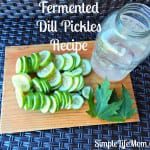
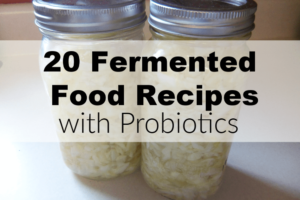
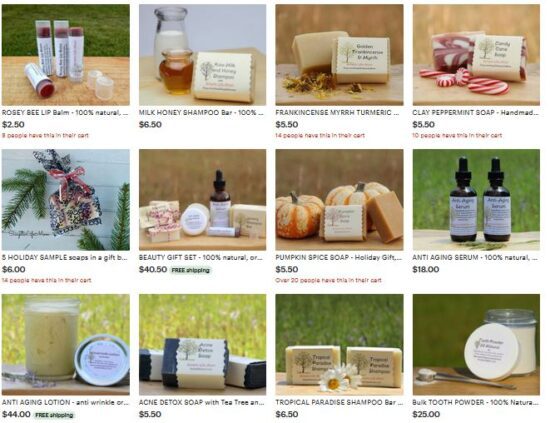
26 Comments
Leave your reply.